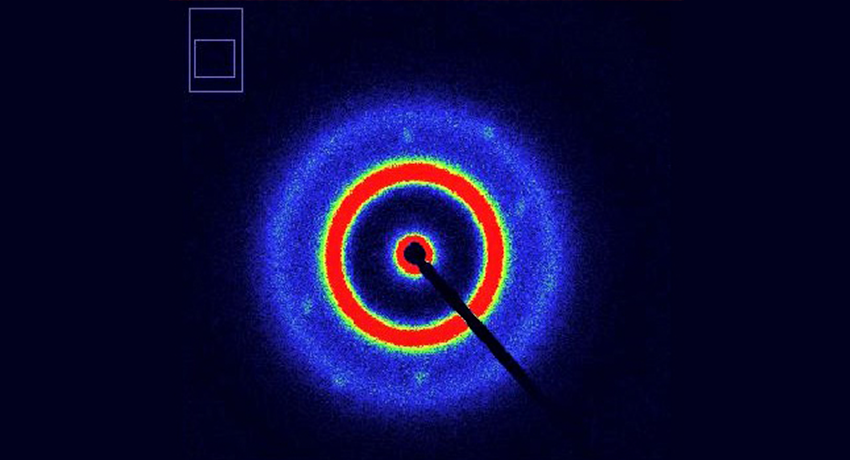The term X-ray Scattering encompasses a number of techniques. X-ray diffraction (XRD), Small (SAXS) and Wide (WAXS) angle X-ray scattering, and X-ray fluorescence (XRF) are three types of X-ray scattering measurements that MCL offers to characterize materials. The term XRD has traditionally been applied to well-ordered crystalline materials for determination of crystal structures, identification of phase composition, stress measurements, and preferred orientation and crystallinity determination, whereas the terms SAXS and WAXS have been applied to the characterization of non- or semi-crystalline materials. SAXS experiments can study electron density structures in materials on size scales greater than the electron density contrast due to atomic ordering observed in diffraction from crystalline materials and can provide information on size, shape, and distribution of electron density contrasted domains. Diffuse scattering to wide angles (WAXS) can study atomic structure in non-crystalline materials. X-ray fluorescence (XRF) is commonly used to identify the elemental composition of materials.
A variety of samples can be measured including bulk specimens, powders, thin films, liquids, gels, emulsions and more. In situ capabilities include the ability to work with wet or air sensitive specimens, at temperatures from -196 to 1600 C, in air, vacuum, or a variety of gases and at pressures up to 100 bar. These capabilities are summarized in the table below.
| Instrument | Source | Goniometer | Optics | Focus | Mode | Detector | Applications |
|---|---|---|---|---|---|---|---|
| Malvern Panalytical Empyrean II | Cu, Co, Mo | 3-axis cradle | micro-diffraction, para-focusing, BBHD | line/point | reflection | GaliPIX and X'Celerator | powder, bulk, metals, polymers, many others, sample changer, non-ambient (Anton Paar HTK1200N and 2000N) |
| Malvern Panalytical Empyrean III | Cu | theta-theta | multi-core | line or microbeam | reflection | PIXcel 3D | powder, bulk, metals, polymers, many others, sample changer |
| Malvern Panalytical Empyrean IV | Cu | theta-theta | multi-core | line or microbeam | reflection | PIXcel 3D and 1Der | powder, bulk, metals, polymers, many others, sample changer |
| Malvern Panalytical - MRD | Cu, Cr | 4-circle | high resolution, para-focusing, focusing lens | line/point | reflection | PIXcel 3D and Xe proportional | bulk/thin films, Anton Paar DHS900 domed heating stage, in-plane, XRR, residual stress, pole figures |
| XENOCS Xeuss 2.0 SAXS/WAXS | Cu | none | collimation | scatterless slits - point focus | transmission and GIXRD | Dectris Pilatus 200K | polymers, nanoparticles, nanocomposites, etc. Linkam HFSX350, CSS450 and MFS with Xenocs humidity control stage |
| Multiwire Laue | W - white radiation | 3-axis; Bond Barrel | collimation | point | back-reflection | multiwire area | single crystal |

| XRD Instrument (Radiation sources) | Non-ambient Stage | Temp. Range | Environment | Sample Size Limitations | Angle Limitations |
|---|---|---|---|---|---|
| Emp 1 (Mo) | Anton Paar HPC900 | 25 to 900 °C | He, from 1 to 100 bar | Alumina or Inconel cups: 10 mm diameter, 0.8 mm depth | 0 to 160 ° 2θ |
| 25 to 500 °C | Air, Nitrogen, CO2, from 1 to 100 bar | ||||
| Emp2 (Cu, Co, Mo, Ag) | Anton Paar HTK1200N | 25 to 1200 °C | Vacuum (10^-4 mbar), air, inert gases | max. 16 mm diameter | 0 to 164 ° 2θ |
| Anton Paar HTK2000N | 25 to 1600 °C | Vacuum (10^-4 mbar), air, inert gases | ~1cm^2 powder | 4 to 164 ° 2θ | |
| MRD (Cu, Cr) | Anton Paar DHS900 | 25 to 900 °C | Vacuum (10^-1 mbar), air, inert gases, nitrogen | max. 25 mm diameter | 0 to 166 ° 2θ |
| 0 to 85 °ψ (psi) | |||||
| 0 to 360 ° φ (phi) | |||||
| Xuess SAXS/WAXS (Cu) | Linkam HFSX350 | -196 to 350 °C | Vacuum | Capillaries up to 1.7 mm diam. / bulk ~5 mm | 0.0040 - 2.88 A-1 |
| Linkam CSS450 | -50 to 450 °C | Vacuum | 30 mm | 0.0040 - 2.88 A-1 | |
| Linkam MFS with Xenocs Humidity Control | -196 to 350 °C | Compression and tensile force; relative humidity (in air only) from 10-90% for temperatures 25-60 °C | varies widely with setup | 0.0040 - 2.88 A-1 |


